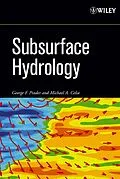With an emphasis on methodology, this reference provides a comprehensive examination of water movement as well as the movement of various pollutants in the earth's subsurface. The multidisciplinary approach integrates earth science, fluid mechanics, mathematics, statistics, and chemistry. Ideal for both professionals and students, this is a practical guide to the practices, procedures, and rules for dealing with groundwater.
Autorentext
GEORGE F. PINDER, PhD, is Director of the Research Center for Groundwater Remediation Design and Professor of Civil and Environmental Engineering, Mathematics, and Computer Science at the University of Vermont. He has published many important articles and books, including Groundwater Modeling Using Geographical Information Systems (Wiley). Dr. Pinder's research focuses on the development and application of applied mathematics, especially numerical mathematics, to solve groundwater contamination and supply problems using computers.
MICHAEL A. CELIA, PhD, is Professor and Chair in the Department of Civil and Environmental Engineering at Princeton University. Dr. Celia conducts research in the areas of groundwater hydrology, numerical modeling, contaminant transport simulation, and multiphase flow physics.
Klappentext
Practices, procedures, and rules for groundwater professionals and students
This text features a comprehensive examination of water movement as well as the movement of various pollutants in the earth's subsurface. The authors also discuss the movement of fluids other than water in the subsurface such as oil, gasoline, and other liquids that may serve as sources of contamination. The multidisciplinary approach covers the topic from both a scientific and engineering perspective, integrating such fields as earth science, fluid mechanics, mathematics, statistics, and chemistry.
Rather than focus on the physical systems themselves, this text takes a practical approach by stressing methodology. Readers are provided with a full discussion of the practices, procedures, and rules for dealing with groundwater. Among the important topics covered are:
- Fluid and multi-fluid flow and transport
- Water movement in geological formations
- Analytical solutions for flow problems
- Well hydraulics
- Numerical solutions of the groundwater flow equation
- Contamination of subsurface water and remediation
- Groundwater and surface water interaction
Figures, diagrams, charts, and tables are used liberally throughout the text to help readers visualize various procedures and subsurface structures. A summary is included at the end of each chapter to highlight key concepts. Problem sets at the end of each chapter give readers an opportunity to test their knowledge and practice their new skills.
With its emphasis on methodology, this is an excellent reference to groundwater principles and practices for any scientist or engineer involved in the field. Moreover, the use of problem sets and the logical presentation of materials make this appropiate as an upper-level undergraduate and graduate textbook for courses in groundwater hydrology and hydrogeology.
Inhalt
Preface.
1. Water and the Subsurface Environment.
1.1 Groundwater Hydrology.
1.2 Groundwater and the Hydrologic Cycle.
1.3 Groundwater as a Resource.
1.4 Groundwater and the Subsurface.
1.5 The Near-surface Environment.
1.5.1 Soil.
1.6 Porosity.
1.6.1 Primary Porosity.
1.6.2 Secondary Porosity.
1.7 SoilWater.
1.8 Groundwater Contamination.
1.8.1 Naturally Occurring Groundwater Contaminants.
1.8.2 Anthropogenic Contaminants.
1.8.3 Superfund.
1.9 Quantitative Analysis of Groundwater Problems.
1.9.1 Governing Equations.
1.9.2 Field Data.
1.9.3 Behavior of Groundwater Systems.
1.10 Summary.
1.11 Problems.
2. Fluid Flow and Mass Transport.
2.1 Fluid Pressure.
2.2 Hydraulic Head.
2.3 Fluid Potential.
2.4 Concept of Saturation.
2.5 The Darcy Experiment.
2.5.1 Extended Forms of Darcy?s Law.
2.5.2 Example of a Groundwater Flow Velocity Calculation in Two Dimensions.
2.5.3 Additional Concepts of Fluid Potential.
2.6 Fluid Flow andMass and Energy Fluxes.
2.6.1 Convection, Diffusion, and Dispersion.
2.6.2 The Phenomena of Adsorption and Retardation.
2.7 Summary.
2.8 Problems.
3. The Geologic Setting.
3.1 Unconsolidated Deposits.
3.1.1 Clastic Sedimentary Environment.
3.1.2 Precipitate Sedimentary Environment.
3.1.3 Glacial Environments.
3.2 Consolidated Rocks.
3.3 Metamorphic Rocks.
3.4 Igneous Rocks.
3.5 Geologic Time.
3.5.1 The Hadean Era.
3.5.2 The Archaean Era.
3.5.3 Proterozoic Era.
3.5.4 Paleozoic Era.
3.5.5 Mesozoic Era.
3.5.6 Cenozoic Era.
3.6 Field Investigation.
3.6.1 Near-surface Investigation.
3.6.2 Deep Subsurface Investigation.
3.7 The Geohydrological Record.
3.7.1 The Cross Section.
3.7.2 The ContourMap.
3.8 TheMeasurement of State Variables.
3.8.1 Water-levelMeasurements.
3.8.2 Solute ConcentrationMeasurements.
3.9 Summary.
3.10 Problems.
4. Water Movement in Geological Formations.
4.1 Conservation of FluidMass.
4.2 Conservation of FluidMass in a PorousMedium.
4.3 Groundwater Flow Equations.
4.3.1 The Governing Equation.
4.3.2 Parameter Estimates.
4.3.3 Boundary Conditions.
4.3.4 Initial Conditions.
4.3.5 Sources and Sinks.
4.4 The Free Surface Condition.
4.5 Reduction in Dimensionality.
4.5.1 Physical Dimensions of the Model.
4.5.2 Vertical Integration of the Flow Equation.
4.5.3 The Free-Surface Condition in the ArealModel.
4.6 Salt-water Intrusion.
4.7 One-dimensional Formulation.
4.8 Cylindrical Coordinates.
4.9 Summary.
4.10 Problems.
5. Analytical Solutions for Flow Problems.
5.1 One-dimensional Flow Problems.
5.1.1 Darcy Column Experiments.
5.1.2 One-dimensional Regional Flow.
5.1.3 Flow in Radial Coordinates.
5.2 Two-dimensional Flow Problems.
5.2.1 Graphical Solutions.
5.2.2 Analytical Solutions in Two Dimensions.
5.3 Summary.
5.4 Problems.
6. Well Hydraulics.
6.1 The Slug Test.
6.1.1 HvorslevMethod.
6.1.2 Cooper-Bredehoeft-Papadopulos.
6.2 Pumping Tests.
6.2.1 ThiemMethod.
6.2.2 TheisMethod.
6.2.3 Cooper-JacobMethod.
6.2.4 Papadopulos-CooperMethod.
6.2.5 Hantush Leaky AquitardMethod.
6.2.6 Neuman Method fo...
